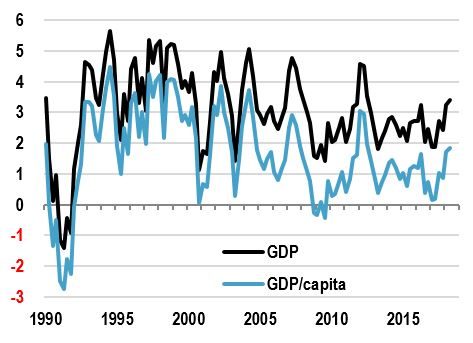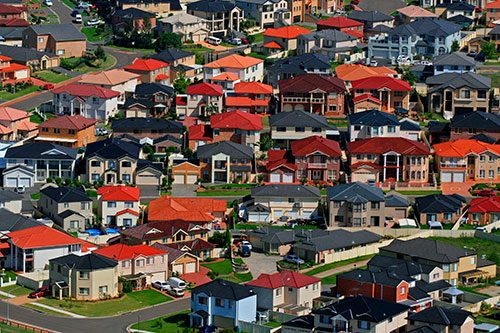- Population growth, productivity growth, commodity exports to China and other fast-growing Asian economies have played an important role together with policy aimed at enhancing economic flexibility
- The floating exchange rate has been an important countercyclical and hence stabilising factor
- The housing boom has become a source of concern from a financial stability perspective with recent prudential measures allowing for a “positive correction”
Visiting Australia is quite an experience. Coming from Europe, there is the sheer number of hours spent in a plane. Upon my arrival last week, it turned out I had just missed a major sand storm and soon after leaving there were torrential rains. Weather conditions may at times be spectacular, so is the economic performance.
This is a country that is in its 108th quarter of uninterrupted growth implying that for the past 27 years it has been without a recession. GDP growth is forecast to continue to exceed 3%. With a median age of the workforce of 38 years, many people haven’t experienced a recession for their entire working career. The picture in the eurozone or the US is quite different. What is behind this success story which is all the more impressive considering that over this period we have seen the Asian debt crisis, the bursting of the TMT bubble, several recessions in Japan – a major trading partner – and the global financial crisis of 2008. Was it a question of luck or good policy?

Source: Thomson Reuters, BNP Paribas
In 2010, the deputy governor of the Reserve Bank of Australia gave a speech on “Twenty years of economic growth”, providing an overview of the growth drivers [1]. Many of the explanations remain relevant. Population growth has been a factor, both on the demand side and the supply side, by supporting a faster pace of potential GDP growth. Another factor is the exposure to China and its huge demand for commodities (iron and coal). More recently, China has become a particularly important client of the agriculture and services sectors, including tourism and education. The flexibility of the Australian economy has been a key factor in the sustained growth performance and top of the list is the flexibility of the exchange rate. The decision in 1983 to float the Australian dollar is generally considered as the single most important policy decision taken in recent decades.
In a commodity rich economy where swings in volumes and commodity prices can have a big impact, the floating exchange rate acts as a countercyclical factor: booming commodity exports will trigger a currency appreciation which helps in avoiding an overheating of the economy. Various other reforms are credited with having boosted productivity growth in the 1990s: competition and industry policy, measures to increase labour market flexibility, financial system reforms and central bank independence. As a consequence, government finances improved significantly, including a reduction in the debt/GDP ratio, which in turn increased fiscal policy leeway to support growth if needed, like in 2008.
Now in its 108th quarter, Australia has had 27 years of uninterrupted growth and counting, with GDP growth forecast to continue to exceed 3%.
William
De Vijlder, Group Chief Economist, BNP Paribas
All this does not mean that the country is not facing challenges. One is population growth, essentially driven by immigration, which requires the economy to create enough and the right type of jobs in order to avoid an increase in unemployment (currently around 5%; annual working age population growth has fluctuated between 1.5% and 1.7% in recent years) and maintain positive per capita GDP growth. As shown in the chart, per capita growth has obviously been slower than GDP growth – and on this measure there was a very shallow recession in Q4 2008 and Q1 2009.

Another challenge is exposure to China, although according to the IMF, Australia’s diversified economy helps to cushion the impact of negative growth shocks coming from China. Moreover the “trade linkages of the rest of Asia with Australia are similar in size to those between Australia and China” [2]. In addition, there is, due to a variety of reasons, a lack of growth in real wages and the Reserve Bank of Australia considers this is an issue for sustaining prosperity [3]. The housing market has increasingly become an area of attention after years of significant price increases fuelled by the build-up of mortgage debt. Measures to cool down the market have contributed to a recent decline in house prices, deemed a positive correction rather than anything more concerning, albeit with price levels still challenging affordability.
[1] Twenty Years of Economic Growth, Speech given by Ric Battellino, Deputy Governor, Reserve Bank of Australia Bulletin, September Quarter 2010
[2] Australia’s linkages with China: prospects and ramifications of China’s economic transition, Philippe Karam and Dirk Muir, IMF working paper 18/119, 2018
[3] To quote Philip Lowe, governor of the Reserve Bank of Australia: “some pick-up in wages growth would be a welcome development. It would help deliver a rate of inflation consistent with the target, it would help with the debt situation and it would add to our sense of shared prosperity.” (“Productivity, Wages and Prosperity”, speech by Philip Lowe, 13 June 2018)